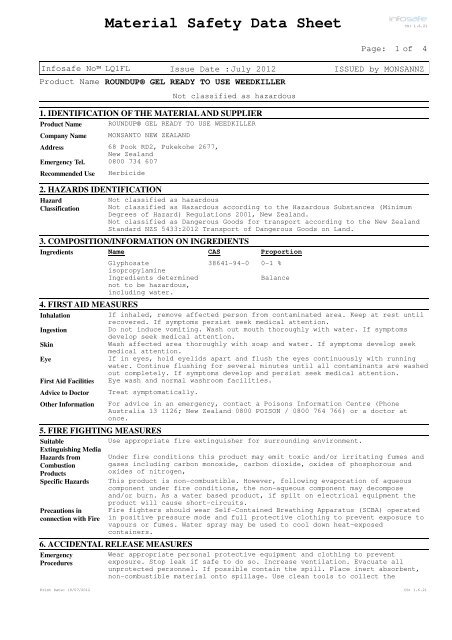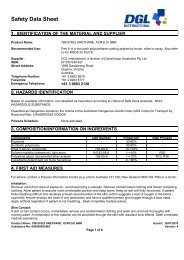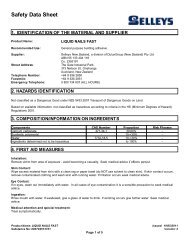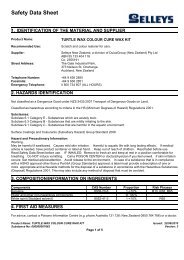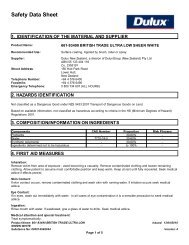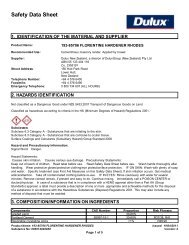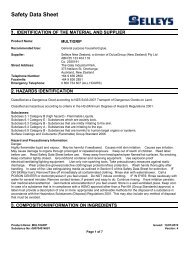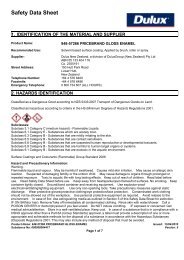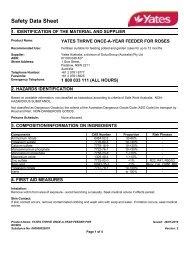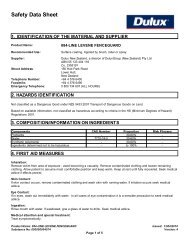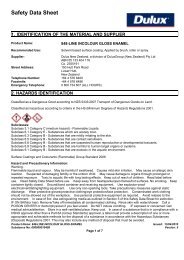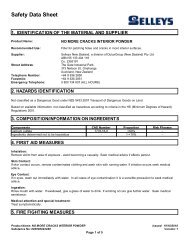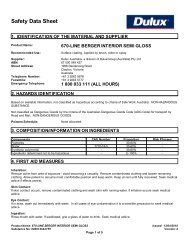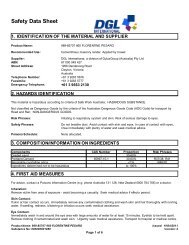roundup® gel ready to use weedkiller - MSDS
roundup® gel ready to use weedkiller - MSDS
roundup® gel ready to use weedkiller - MSDS
You also want an ePaper? Increase the reach of your titles
YUMPU automatically turns print PDFs into web optimized ePapers that Google loves.
Material Safety Data Sheet<br />
Page: 1 of<br />
CS: 1.6.21<br />
Infosafe No LQ1FL Issue Date : July 2012 ISSUED by MONSANNZ<br />
Product Name : ROUNDUP® GEL READY TO USE WEEDKILLER<br />
Not classified as hazardous<br />
1. IDENTIFICATION OF THE MATERIAL AND SUPPLIER<br />
ROUNDUP® GEL READY TO USE WEEDKILLER<br />
Product Name<br />
Company Name<br />
Address<br />
Emergency Tel.<br />
Recommended Use<br />
MONSANTO NEW ZEALAND<br />
68 Pook RD2, Pukekohe 2677,<br />
New Zealand<br />
0800 734 607<br />
Herbicide<br />
2. HAZARDS IDENTIFICATION<br />
Hazard<br />
Classification<br />
Not classified as hazardous<br />
Not classified as Hazardous according <strong>to</strong> the Hazardous Substances (Minimum<br />
Degrees of Hazard) Regulations 2001, New Zealand.<br />
Not classified as Dangerous Goods for transport according <strong>to</strong> the New Zealand<br />
Standard NZS 5433:2012 Transport of Dangerous Goods on Land.<br />
3. COMPOSITION/INFORMATION ON INGREDIENTS<br />
Name CAS Proportion<br />
Ingredients<br />
4. FIRST AID MEASURES<br />
Inhalation<br />
Ingestion<br />
Skin<br />
Eye<br />
First Aid Facilities<br />
Advice <strong>to</strong> Doc<strong>to</strong>r<br />
Other Information<br />
Glyphosate<br />
isopropylamine<br />
Ingredients determined<br />
not <strong>to</strong> be hazardous,<br />
including water.<br />
38641-94-0 0-1 %<br />
Balance<br />
If inhaled, remove affected person from contaminated area. Keep at rest until<br />
recovered. If symp<strong>to</strong>ms persist seek medical attention.<br />
Do not induce vomiting. Wash out mouth thoroughly with water. If symp<strong>to</strong>ms<br />
develop seek medical attention.<br />
Wash affected area thoroughly with soap and water. If symp<strong>to</strong>ms develop seek<br />
medical attention.<br />
If in eyes, hold eyelids apart and flush the eyes continuously with running<br />
water. Continue flushing for several minutes until all contaminants are washed<br />
out completely. If symp<strong>to</strong>ms develop and persist seek medical attention.<br />
Eye wash and normal washroom facilities.<br />
Treat symp<strong>to</strong>matically.<br />
5. FIRE FIGHTING MEASURES<br />
Suitable<br />
Extinguishing Media<br />
Hazards from<br />
Combustion<br />
Products<br />
Specific Hazards<br />
Precautions in<br />
connection with Fire<br />
For advice in an emergency, contact a Poisons Information Centre (Phone<br />
Australia 13 1126; New Zealand 0800 POISON / 0800 764 766) or a doc<strong>to</strong>r at<br />
once.<br />
Use appropriate fire extinguisher for surrounding environment.<br />
Under fire conditions this product may emit <strong>to</strong>xic and/or irritating fumes and<br />
gases including carbon monoxide, carbon dioxide, oxides of phosphorous and<br />
oxides of nitrogen,<br />
This product is non-combustible. However, following evaporation of aqueous<br />
component under fire conditions, the non-aqueous component may decompose<br />
and/or burn. As a water based product, if spilt on electrical equipment the<br />
product will ca<strong>use</strong> short-circuits.<br />
Fire fighters should wear Self-Contained Breathing Apparatus (SCBA) operated<br />
in positive pressure mode and full protective clothing <strong>to</strong> prevent exposure <strong>to</strong><br />
vapours or fumes. Water spray may be <strong>use</strong>d <strong>to</strong> cool down heat-exposed<br />
containers.<br />
6. ACCIDENTAL RELEASE MEASURES<br />
Emergency<br />
Procedures<br />
Wear appropriate personal protective equipment and clothing <strong>to</strong> prevent<br />
exposure. S<strong>to</strong>p leak if safe <strong>to</strong> do so. Increase ventilation. Evacuate all<br />
unprotected personnel. If possible contain the spill. Place inert absorbent,<br />
non-combustible material on<strong>to</strong> spillage. Use clean <strong>to</strong>ols <strong>to</strong> collect the<br />
Print Date: 19/07/2012 CS: 1.6.21<br />
4
Material Safety Data Sheet<br />
Page: 2 of<br />
CS: 1.6.21<br />
Infosafe No LQ1FL Issue Date : July 2012 ISSUED by MONSANNZ<br />
Product Name : ROUNDUP® GEL READY TO USE WEEDKILLER<br />
7. HANDLING AND STORAGE<br />
Precautions for Safe<br />
Handling<br />
Conditions for Safe<br />
S<strong>to</strong>rage<br />
S<strong>to</strong>rage<br />
Temperatures<br />
Recommended<br />
Materials<br />
Unsuitable Materials<br />
Not classified as hazardous<br />
material and place in<strong>to</strong> suitable labelled containers for subsequent recycling<br />
or disposal. Dispose of waste according <strong>to</strong> the applicable local and national<br />
regulations. If contamination of sewers or waterways occurs inform the local<br />
water and waste management authorities in accordance with local regulations.<br />
Use only in a well ventilated area. Keep containers sealed when not in <strong>use</strong>.<br />
Prevent the build up of mists or vapours in the work atmosphere. Avoid<br />
inhalation of vapours and mists, and skin or eye contact. Do not re-<strong>use</strong><br />
containers. Maintain high standards of personal hygiene i.e. Washing hands<br />
prior <strong>to</strong> eating, drinking, smoking or using <strong>to</strong>ilet facilities.<br />
S<strong>to</strong>re in a cool, dry, well-ventilated area, out of direct sunlight. S<strong>to</strong>re in<br />
suitable, labelled containers. Keep containers closed when not in <strong>use</strong>. Ensure<br />
that s<strong>to</strong>rage conditions comply with applicable local and national regulations.<br />
Minimum s<strong>to</strong>rage temperature: -15 °C<br />
Maximum s<strong>to</strong>rage temperature: 50 °C<br />
Compatible materials: stainless steel, fibreglass, plastic, glass lining<br />
Incompatible materials: galvanised steel, unlined mild steel.<br />
8. EXPOSURE CONTROLS/PERSONAL PROTECTION<br />
National Exposure<br />
Standards<br />
Biological Limit<br />
Values<br />
Engineering<br />
Controls<br />
Respira<strong>to</strong>ry<br />
Protection<br />
Eye Protection<br />
Hand Protection<br />
Body Protection<br />
No exposure standards have been established for the material by the<br />
Occupational Safety and Health Service (OSH) of the New Zealand Department of<br />
Labour. However, over-exposure <strong>to</strong> some chemicals may result in enhancement of<br />
pre-existing adverse medical conditions and/or allergic reactions and should<br />
be kept <strong>to</strong> the least possible levels.<br />
No biological limits allocated.<br />
Use with good general ventilation. If mists or vapours are produced, local<br />
exhaust ventilation should be <strong>use</strong>d.<br />
If engineering controls are not effective in controlling airborne exposure<br />
then an approved respira<strong>to</strong>r with a replaceable filter should be <strong>use</strong>d.<br />
Reference should be made <strong>to</strong> Australian/New Zealand Standards AS/NZS 1715,<br />
Selection, Use and Maintenance of Respira<strong>to</strong>ry Protective Devices; and AS/NZS<br />
1716, Respira<strong>to</strong>ry Protective Devices, in order <strong>to</strong> make any necessary changes<br />
for individual circumstances.<br />
Safety glasses with side shields or chemical goggles should be worn. Final<br />
choice of appropriate eye/face protection will vary according <strong>to</strong> individual<br />
circumstances. Eye protection devices should conform with Australian/New<br />
Zealand Standard AS/NZS 1337 - Eye Protec<strong>to</strong>rs for Industrial Applications.<br />
Wear gloves of impervious material. Final choice of appropriate gloves will<br />
vary according <strong>to</strong> individual circumstances i.e. methods of handling or<br />
according <strong>to</strong> risk assessments undertaken. Reference should be made <strong>to</strong> AS/NZS<br />
2161.1: Occupational protective gloves - Selection, <strong>use</strong> and maintenance.<br />
Suitable protective workwear, e.g. cot<strong>to</strong>n overalls but<strong>to</strong>ned at neck and wrist<br />
is recommended. Chemical resistant apron is recommended where large quantities<br />
are handled.<br />
9. PHYSICAL AND CHEMICAL PROPERTIES<br />
Colourless homogenous <strong>gel</strong><br />
Appearance<br />
Odour<br />
Freezing Point<br />
Boiling Point<br />
Solubility in Water<br />
Specific Gravity<br />
pH Value<br />
Vapour Pressure<br />
Vapour Density<br />
(Air=1)<br />
Mild odour<br />
0°C (water)<br />
100°C (water)<br />
Completely miscible<br />
1.016 at 20/4°C<br />
7.2 (5% solution)<br />
Not available<br />
Not available<br />
Print Date: 19/07/2012 CS: 1.6.21<br />
4
Material Safety Data Sheet<br />
Page: 3 of<br />
CS: 1.6.21<br />
Infosafe No LQ1FL Issue Date : July 2012 ISSUED by MONSANNZ<br />
Product Name : ROUNDUP® GEL READY TO USE WEEDKILLER<br />
Octanol/Water<br />
Partition Coefficient<br />
Flash Point<br />
Flammability<br />
Au<strong>to</strong>-Ignition<br />
Temperature<br />
Flammable Limits -<br />
Lower<br />
Flammable Limits -<br />
Upper<br />
Not classified as hazardous<br />
log Pow: -3.2 @ 25 °C (glyphosate)<br />
Not applicable<br />
Not flammable<br />
Not available<br />
Not available<br />
Not available<br />
10. STABILITY AND REACTIVITY<br />
Stable under normal conditions of s<strong>to</strong>rage and handling.<br />
Chemical Stability<br />
Conditions <strong>to</strong> Avoid<br />
Incompatible<br />
Materials<br />
Hazardous<br />
Decomposition<br />
Products<br />
Hazardous<br />
Polymerization<br />
Extremes of temperature<br />
Reacts with galvanised steel or unlined mild steel <strong>to</strong> produce hydrogen, a<br />
highly flammable gas that could explode.<br />
Thermal decomposition may result in the release of <strong>to</strong>xic and/or irritating<br />
fumes and gases including carbon monoxide, carbon dioxide, oxides of<br />
phosphorous and oxides of nitrogen,<br />
Will not occur<br />
11. TOXICOLOGICAL INFORMATION<br />
Toxicology<br />
Information<br />
Inhalation<br />
Ingestion<br />
Skin<br />
Eye<br />
Reproductive<br />
Toxicity<br />
Carcinogenicity<br />
Acute Toxicity - Oral<br />
Acute Toxicity -<br />
Dermal<br />
Skin Sensitisation<br />
No <strong>to</strong>xicity data available for this material. The available acute <strong>to</strong>xicity<br />
data for the active ingredient is given below<br />
Inhalation of product vapours may ca<strong>use</strong> irritation of the nose, throat and<br />
respira<strong>to</strong>ry system.<br />
Ingestion of this product may irritate the gastric tract causing na<strong>use</strong>a and<br />
vomiting.<br />
May be irritating <strong>to</strong> skin. The symp<strong>to</strong>ms may include redness, itching and<br />
swelling. Prolonged or repeated skin contact may ca<strong>use</strong> defatting leading <strong>to</strong><br />
dermatitis.<br />
May be irritating <strong>to</strong> eyes. The symp<strong>to</strong>ms may include redness, itching and<br />
tearing.<br />
Not considered <strong>to</strong> be <strong>to</strong>xic <strong>to</strong> reproduction<br />
Not considered <strong>to</strong> be a carcinogenic hazard<br />
Rat:> 2,000 mg/kg body weight<br />
Rat:> 2,000 mg/kg body weight<br />
12. ECOLOGICAL INFORMATION<br />
Eco<strong>to</strong>xicity<br />
Persistence /<br />
Degradability<br />
Mobility<br />
Bioaccumulative<br />
Potential<br />
Environ. Protection<br />
Acute Toxicity - Fish<br />
Not expected <strong>to</strong> be a skin sensitiser<br />
No ecological data available for this material. The available ecological data<br />
for the active ingredient is given below:<br />
Not available<br />
Not available<br />
Not available<br />
13. DISPOSAL CONSIDERATIONS<br />
Prevent this material entering waterways, drains and sewers.<br />
Bluegill sunfish (Lepomis macrochirus):<br />
Acute <strong>to</strong>xicity, 96 hours, static, LC50: 120 mg/L<br />
Rainbow trout (Oncorhynchus mykiss):<br />
Acute <strong>to</strong>xicity, 96 hours, static, LC50: 86 mg/L<br />
Print Date: 19/07/2012 CS: 1.6.21<br />
4
Material Safety Data Sheet<br />
Page: 4 of<br />
CS: 1.6.21<br />
Infosafe No LQ1FL Issue Date : July 2012 ISSUED by MONSANNZ<br />
Product Name : ROUNDUP® GEL READY TO USE WEEDKILLER<br />
Disposal<br />
Considerations<br />
14. TRANSPORT INFORMATION<br />
Transport<br />
Information<br />
IMDG Marine<br />
Pollutant (MP)<br />
Not classified as hazardous<br />
This product can be disposed through a licensed commercial waste collection<br />
service, in accordance with applicable local and national regulations. This<br />
product is non-hazardous and therefore the New Zealand HSNO regulations<br />
regarding disposal do not apply. However other regulations may apply.<br />
This is a water-based/water-soluble product and therefore can be sent through<br />
a Waste Water Treatment Plant and after treatment can be discharged in<strong>to</strong><br />
environment through the sewerage or drainage systems as authorized.<br />
Container Disposal:<br />
Empty packaging completely. S<strong>to</strong>re for collection by approved waste disposal<br />
service. Dispose of as non hazardous industrial waste. Do NOT re-<strong>use</strong><br />
containers.<br />
Road and Rail Transport:<br />
Not classified as Dangerous Goods for transport according <strong>to</strong> the NZS 5433:2012<br />
Transport of Dangerous Goods on Land.<br />
Marine Transport (IMO/IMDG):<br />
Not classified as Dangerous Goods by the criteria of the International<br />
Maritime Dangerous Goods Code (IMDG Code) for transport by sea.<br />
Air Transport (ICAO/IATA):<br />
Not classified as Dangerous Goods by the criteria of the International Air<br />
Transport Association (IATA) Dangerous Goods Regulations for transport by air.<br />
No<br />
15. REGULATORY INFORMATION<br />
Regula<strong>to</strong>ry<br />
Information<br />
16. OTHER INFORMATION<br />
Date of preparation<br />
or last revision of<br />
<strong>MSDS</strong><br />
Not classified as Hazardous according <strong>to</strong> the New Zealand Hazardous Substances<br />
(Minimum Degrees of Hazard) Regulations 2001.<br />
SDS Created: July 2012<br />
...End Of <strong>MSDS</strong>...<br />
© Copyright ACOHS Pty Ltd<br />
Copyright in the source code of the HTML, PDF, XML, XFO and any other electronic files rendered by an Infosafe system for Infosafe <strong>MSDS</strong> displayed is the intellectual<br />
property of Acohs Pty Ltd.<br />
Copyright in the layout, presentation and appearance of each Infosafe <strong>MSDS</strong> displayed is the intellectual property of Acohs Pty Ltd.<br />
The compilation of <strong>MSDS</strong>'s displayed is the intellectual property of Acohs Pty Ltd.<br />
Copying of any <strong>MSDS</strong> displayed is permitted for personal <strong>use</strong> only and otherwise is not permitted. In particular the <strong>MSDS</strong>'s displayed cannot be copied for the purpose of<br />
sale or licence or for inclusion as part of a collection of <strong>MSDS</strong> without the express written consent of Acohs Pty Ltd.<br />
Print Date: 19/07/2012 CS: 1.6.21<br />
4


